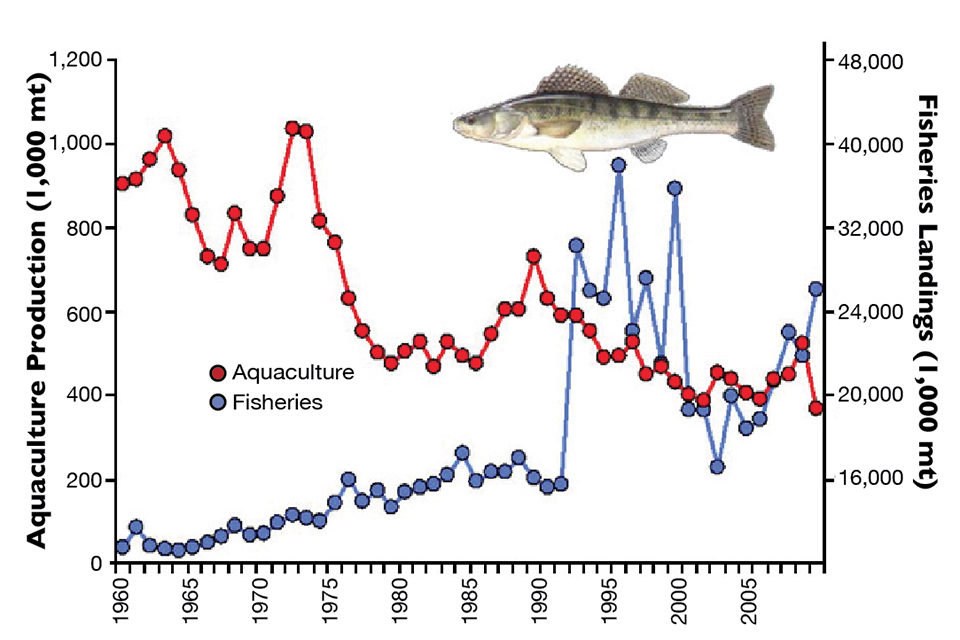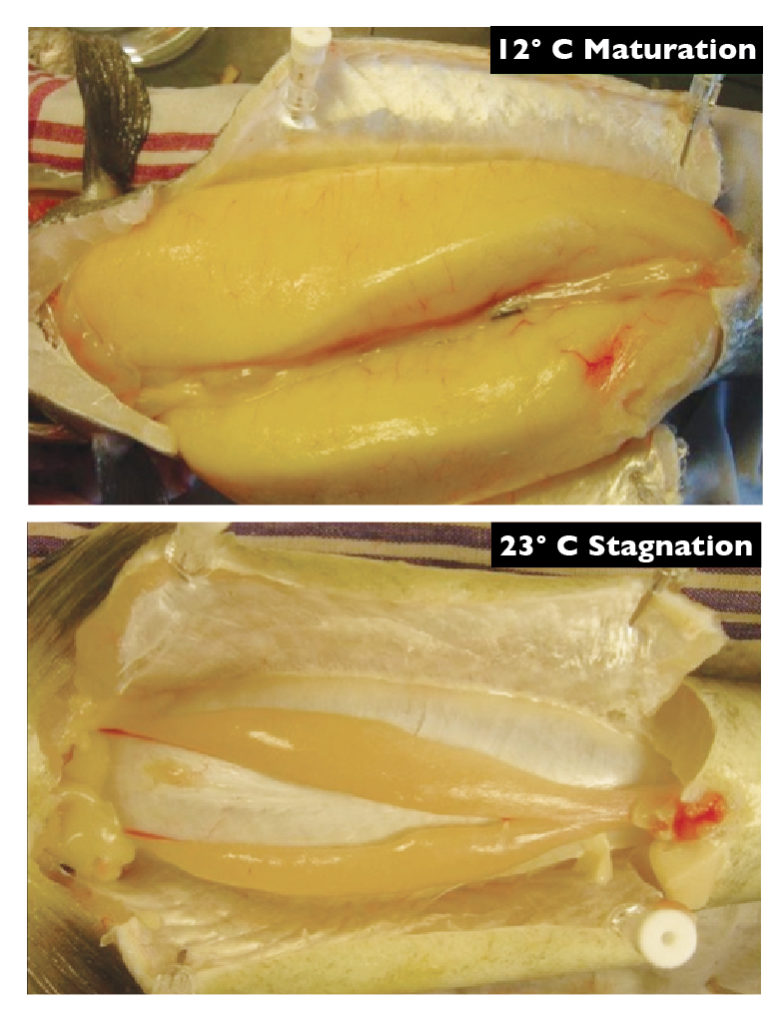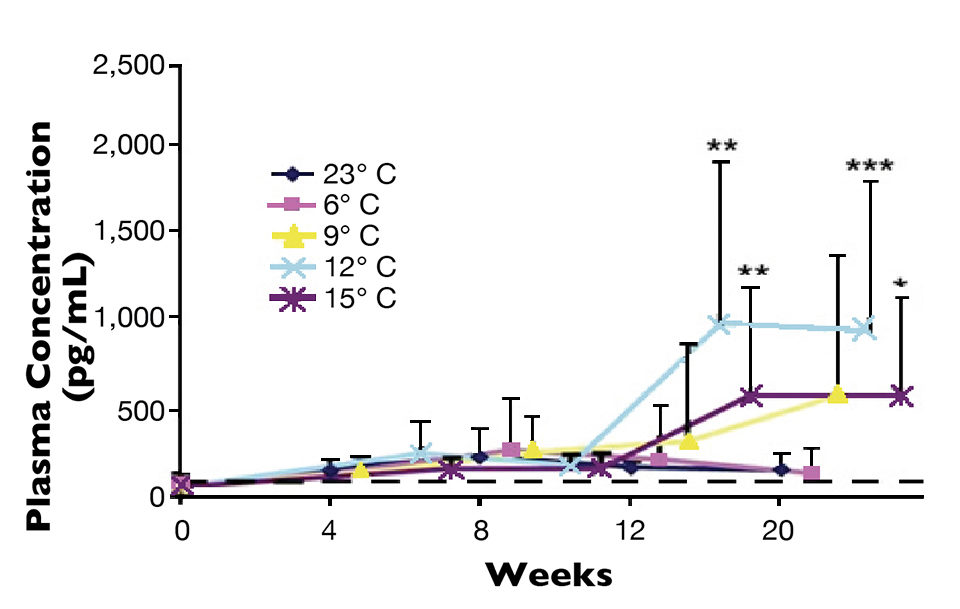Temperature controls gonad maturation, growth performance

Fish and seafood products account for at least 15 percent of the animal protein consumed. Given the stagnation of global fisheries landings, this demand can only be met by aquaculture production in the future. Although global aquaculture production has doubled every decade over the past 40 years, central European aquaculture has stagnated with few exceptions, mainly in marine species.
In Germany, a small domestic production of fish is overwhelmingly opposed by imports of approximately 1.07 mmt. On a national scale, carp and trout are the most important species traditionally grown in pond systems, but recirculation aquaculture of new candidate species is undoubtedly on the rise.
Pike perch
From a European perspective, the pike perch (Sander lucioperca) is among the most promising candidates due to its delicate meat, mild taste and good texture. Pike perch achieve prices above 8 €/kg ($10.50/kg). Currently, perch demand is sustained by imports, mainly from eastern European fisheries.
In contrast to the decreasing fisheries landings, pike perch aquaculture production increased over the last decade (Fig. 1). In Germany, 75 percent of pike perch is imported, whereas locally produced fish (mainly from fisheries) are mostly marketed directly. This indicates an underdeveloped market and potential for aquaculture development.
Aquaculture issues
Pike perch aquaculture is impeded by a shortage of stocking material and so relies mostly on wild breeders. In recent studies focused on reproduction of captive broodstock, a substantial breakthrough was recently achieved by out-of-season reproduction.
Spawning is induced by hormone treatment or manipulation of photoperiod and rearing temperature. If wild spawners are used, they are mainly caught in springtime during spawning migrations.
Upon spawning, eggs are fertilized in vitro after stripping or, in the case of natural reproduction, collected with spawning nests made from vegetation such as conifer branches or spawning mats. At this stage, high mortalities can occur due to insufficient oxygen supply and the development of Saprolegnia species. Still, the induction of final maturation and subsequent spawning are not the most frequent reproductive dysfunctions encountered during closed-cycle aquaculture of pike perch.

Gonad maturation
As in several other species, the initiation of gonad maturation (puberty) is often impeded, and gonad development can stagnate at an early stage. This stagnation in gonad development is more prominent in females, but is also seen in males.
In female pike perch, this stagnation occurs at the transition from previtellogenesis to vitellogenesis, at a stage when yolk accumulation is initiated. At this stage, intracellular vesicles indicate the forthcoming uptake of the yolk protein, which serves as nutritional storage protein during embryo development. Although developmental stagnation is more prominent in juvenile females, similar arrest can be observed at the onset of spermatogenesis.
Thus, in captivity, reproductive dysfunction is reflected in females’ estradiol sex steroid hormone and males’ 11-ketotestosterone hormone – leading to a stagnation of gonad maturation in both sexes and impairing the recruitment of breeders. Although the ultimate cause is most likely a result of the artificial rearing conditions, the hormone system proximately integrates these triggers on a physiological level. Therefore, sexual steroids in the plasma represent a powerful tool to diagnose and overcome unfavorable rearing conditions.
Endocrine regulation
The hormone system that regulates reproduction in fish comprises three endocrine tissues: the brain, the pituitary and the gonad. External factors, such as photoperiod and temperature, are integrated at the level of the brain, initiating a cascade of hormones via the pituitary to the gonad, finally inducing the synthesis of sexual steroids that initiate maturation of the testis and the ovary.
Consequently, the concentrations of estradiol and 11-keto-testosterone in blood can be used to detect reproductive stages. For example, in female perch kept at temperatures of 6, 9, 12, 15 or 23 degrees-C under a photoperiod of 12 hours light and 12 hours dark over a 20-week period, synthesis of estradiol was significantly inhibited at 23 degrees-C, whereas the highest estradiol concentrations were detected at 12 degrees-C (Fig. 2).

Correspondingly, histology of the gonads revealed that maturation initiated earlier at 12 degrees C than at 9 or 15 degrees-C, whereas at 23 degrees-C, maturation stagnated at a previtellogenic stage. Similarly, the principal male sex steroid 11-ketotestosterone peaked at 9 to 15 degrees-C, characterizing this range as optimum for perch reproduction. At 23 degrees-C, complete stagnation of gonad development occured in males and females.
Temperature control
During gonad maturation, substantial energy is recruited for gonad development. Rapid growth of the organ is often used by fish biologists as a proxy for maturation known as the gonadosomatic index (GSI). The index is calculated as a ratio of gonad weight:body weight.
In pike perch, relative gonad size sharply rises at the onset of gonad maturation from approximately 0.4 percent in males and slightly higher in females. As a consequence of the energy shift required for maturation, body growth decreases. In contrast, at a high temperature of 23 degrees-C, gonad maturation is inhibited, and GSI values remain low.
From a practical view, high rearing temperatures suppress gonad growth and consequently improve growth potential as well as food conversion. Obviously, temperature control of gonad maturation is only economically feasible in sophisticated recirculation aquaculture systems.
Perspectives
Temperature protocols are key to year-round production of pike perch, which could provide a long-term competitive advantage, compensate higher investment and running costs and ultimately promote recirculation technology for pike perch aquaculture. Due to the natural distribution of the species, population-specific temperature adaptations may exist that would avoid the need to adjust established protocols for new stocking material.
(Editor’s Note: This article was originally published in the July/August 2012 print edition of the Global Aquaculture Advocate.)
Authors
-
Sven Wuertz, Ph.D.
Leibniz Institute
Freshwater Ecology and Inland Fisheries Department
Ecophysiology and Aquaculture
Müggelseedamm 310
12587 Berlin, Germany -
Björn Hermelink, M.S.
Werner Kloas, Ph.D.
Leibniz Institute
Freshwater Ecology and Inland Fisheries Department
Ecophysiology and Aquaculture -
Carsten Schulz, Ph.D.
Gesellschaft für Marine Aquakultur mbH
Büsum, Germany
Tagged With
Related Posts

Health & Welfare
Aquaculture in Germany
Germany produces a limited amount of carp, trout, mussels and other species. Although traditional pond-based farms continue to operate, the country’s aquaculture production is trending toward land-based systems that feature efficient resource use and reduced environmental impacts.

Responsibility
A look at various intensive shrimp farming systems in Asia
The impact of diseases led some Asian shrimp farming countries to develop biofloc and recirculation aquaculture system (RAS) production technologies. Treating incoming water for culture operations and wastewater treatment are biosecurity measures for disease prevention and control.

Intelligence
An engineer’s design for a classroom aquaculture-aquaponics system
An aquaponics teaching system was designed, built and operated by students at the University of Arizona, integrating its operation and management into the educational curriculum. This engineering design will require minimum maintenance and will last years.

Responsibility
A look at integrated multi-trophic aquaculture
In integrated multi-trophic aquaculture, farmers combine the cultivation of fed species such as finfish or shrimp with extractive seaweeds, aquatic plants and shellfish and other invertebrates that recapture organic and inorganic particulate nutrients for their growth.


